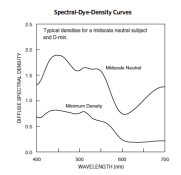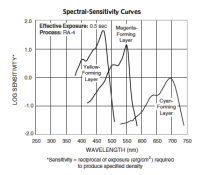polyglot
Member
While I'm not convinced 8 bits is enough control, you can get as much as you want from an Arduino because you don't need to use the built-in PWM channels. The PWM frequency need not be high so you can do it in software to as much resolution as you want.
The greater problem IMHO is the C41/RA4 pair was designed with continuous spectrum in mind and using some very non-optimal dye technologies with overlaps, couplers, restraining couplers, etc. You're trying to print with just 3 points in the spectrum, which means your paper will not see all the subtleties of dye interactions (absorption spectra in the neg vs sensitivity spectra in the paper) that it is meant to. To make it worse, most media have more than 3 different dyes, e.g. most Fuji products have at least two green-sensitive dyes in the film and I presume that they are coupled to two subtly different absorption dyes.
The greater problem IMHO is the C41/RA4 pair was designed with continuous spectrum in mind and using some very non-optimal dye technologies with overlaps, couplers, restraining couplers, etc. You're trying to print with just 3 points in the spectrum, which means your paper will not see all the subtleties of dye interactions (absorption spectra in the neg vs sensitivity spectra in the paper) that it is meant to. To make it worse, most media have more than 3 different dyes, e.g. most Fuji products have at least two green-sensitive dyes in the film and I presume that they are coupled to two subtly different absorption dyes.












